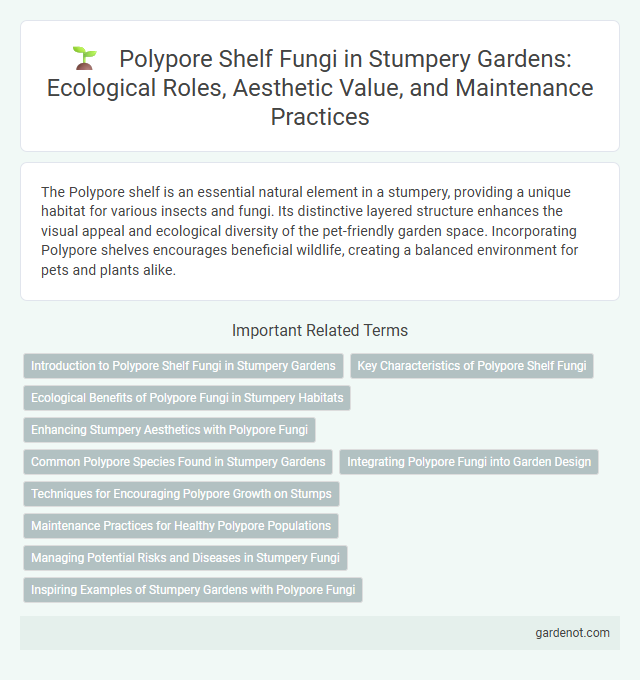The Polypore shelf is an essential natural element in a stumpery, providing a unique habitat for various insects and fungi. Its distinctive layered structure enhances the visual appeal and ecological diversity of the pet-friendly garden space. Incorporating Polypore shelves encourages beneficial wildlife, creating a balanced environment for pets and plants alike.
Introduction to Polypore Shelf Fungi in Stumpery Gardens
Polypore shelf fungi, key components of stumpery gardens, thrive on decaying wood, adding texture and ecological value. These bracket fungi contribute to nutrient cycling by breaking down tough lignin and cellulose within tree stumps and fallen logs. Their distinctive shelf-like fruiting bodies support diverse microhabitats, enhancing biodiversity in woodland-inspired garden designs.
Key Characteristics of Polypore Shelf Fungi
Polypore shelf fungi are characterized by their tough, woody or leathery fruiting bodies that form shelf- or bracket-like structures on tree trunks and fallen logs. They typically exhibit pores or tubes on the underside, which release spores for reproduction. These fungi play a crucial ecological role in decomposing wood, facilitating nutrient cycling in forest ecosystems.
Ecological Benefits of Polypore Fungi in Stumpery Habitats
Polypore shelf fungi play a crucial role in stumpery habitats by decomposing dead wood, facilitating nutrient cycling, and enhancing soil fertility. These fungi create microhabitats for invertebrates, contributing to biodiversity and ecosystem stability. Their presence supports forest regeneration by breaking down lignin and cellulose, promoting healthy woodland ecosystems.
Enhancing Stumpery Aesthetics with Polypore Fungi
Polypore shelf fungi add unique textures and earthy tones that elevate the visual appeal of a stumpery, creating natural focal points on decaying wood. Their rigid, bracket-like formations provide structural contrast, enhancing the overall biodiversity and fostering a dynamic microhabitat. Integrating Polypore fungi supports ecological balance while offering long-lasting beauty through seasonal changes.
Common Polypore Species Found in Stumpery Gardens
Common polypore species found in stumpery gardens include Ganoderma applanatum, known for its large, woody brackets with white pore surfaces, and Trametes versicolor, recognizable by its vibrant, multi-colored bands and thin, shelf-like fruiting bodies. These fungi contribute to wood decomposition and enhance biodiversity by creating microhabitats for insects and other organisms. Fomes fomentarius, another frequent polypore in stumperies, forms hoof-shaped fruiting bodies that serve as important ecological indicators of forest health.
Integrating Polypore Fungi into Garden Design
Polypore shelves, a type of bracket fungi, add unique texture and natural artistry to garden designs by growing on decaying wood and creating focal points with their layered, shelf-like structures. Integrating polypore fungi enhances biodiversity by supporting woodland ecosystems and attracting beneficial insects, while their distinctive forms complement rustic, woodland, or naturalistic garden themes. Gardeners can strategically place logs or deadwood to encourage polypore colonization, merging ecological function with aesthetic appeal in sustainable landscape planning.
Techniques for Encouraging Polypore Growth on Stumps
To encourage polypore shelf growth on stumps within a stumpery, select hardwood stumps such as oak or beech, as they provide an ideal substrate rich in nutrients for fungal colonization. Maintain consistent moisture levels by situating stumps in shaded, humid environments and regularly misting them to mimic the fungi's natural habitat. Inoculating stumps with polypore spores or mycelium plugs boosts colonization speed and ensures robust shelf formation.
Maintenance Practices for Healthy Polypore Populations
Polypore shelf fungi thrive when decaying wood is preserved and monitored for moisture levels to prevent rapid desiccation or waterlogging. Regularly removing competing vegetation and maintaining air circulation around the shelf helps reduce fungal diseases and promotes healthy growth. Monitoring for pests and applying organic fungicides when necessary supports sustainable polypore populations in natural and cultivated environments.
Managing Potential Risks and Diseases in Stumpery Fungi
Polypore shelf fungi in stumperies require careful monitoring to prevent wood decay and fungal diseases that can compromise structural stability. Maintaining proper airflow and avoiding excessive moisture reduces the risk of pathogen outbreaks and helps sustain a healthy fungal community. Regular inspection for signs of rot or invasive fungi enables timely intervention and preservation of the stumpery's ecological balance.
Inspiring Examples of Stumpery Gardens with Polypore Fungi
Polypore shelves add a captivating structural element to stumpery gardens, showcasing the natural artistry of fungi growth on decaying wood. Stumperies featuring species like Ganoderma and Trametes versicolor demonstrate how shelf fungi can enhance biodiversity while creating visually striking, textured landscapes. These inspiring examples highlight the ecological benefits and aesthetic appeal of incorporating polypore fungi into woodland-inspired garden designs.
Polypore shelf Infographic

 gardenot.com
gardenot.com